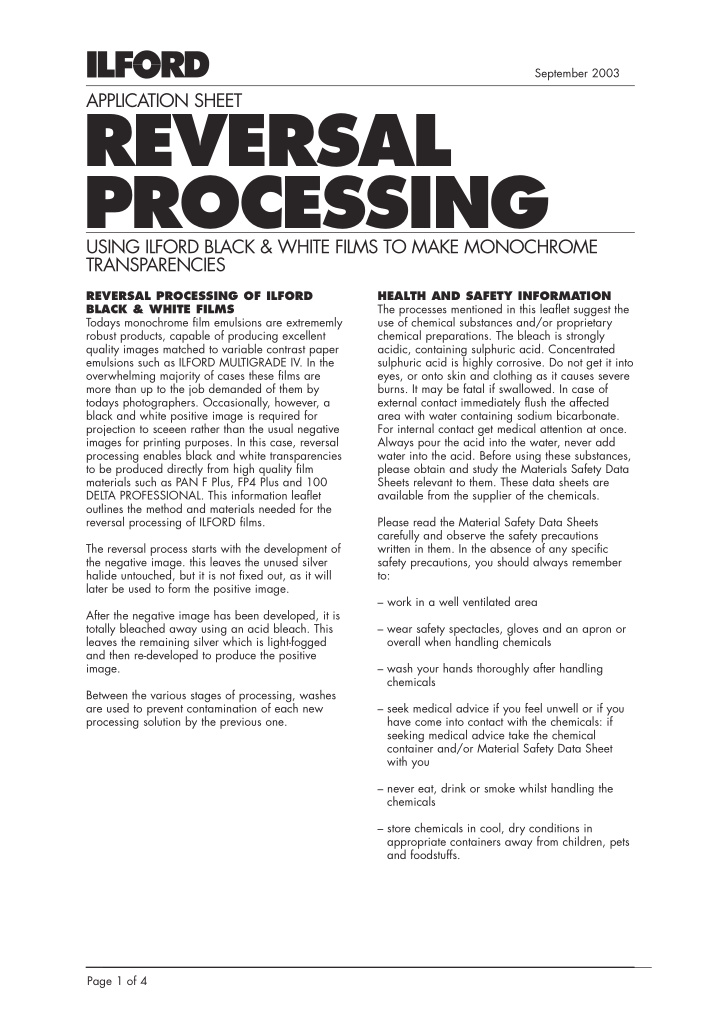



September 2003 APPLICATION SHEET REVERSAL PROCESSING USING ILFORD BLACK & WHITE FILMS TO MAKE MONOCHROME TRANSPARENCIES REVERSAL PROCESSING OF ILFORD HEALTH AND SAFETY INFORMATION The processes mentioned in this leaflet suggest the BLACK & WHITE FILMS Todays monochrome film emulsions are extrememly use of chemical substances and/or proprietary robust products, capable of producing excellent chemical preparations. The bleach is strongly quality images matched to variable contrast paper acidic, containing sulphuric acid. Concentrated emulsions such as ILFORD MULTIGRADE IV. In the sulphuric acid is highly corrosive. Do not get it into overwhelming majority of cases these films are eyes, or onto skin and clothing as it causes severe more than up to the job demanded of them by burns. It may be fatal if swallowed. In case of todays photographers. Occasionally, however, a external contact immediately flush the affected black and white positive image is required for area with water containing sodium bicarbonate. projection to sceeen rather than the usual negative For internal contact get medical attention at once. images for printing purposes. In this case, reversal Always pour the acid into the water, never add processing enables black and white transparencies water into the acid. Before using these substances, to be produced directly from high quality film please obtain and study the Materials Safety Data materials such as PAN F Plus, FP4 Plus and 100 Sheets relevant to them. These data sheets are DELTA PROFESSIONAL. This information leaflet available from the supplier of the chemicals. outlines the method and materials needed for the reversal processing of ILFORD films. Please read the Material Safety Data Sheets carefully and observe the safety precautions The reversal process starts with the development of written in them. In the absence of any specific the negative image. this leaves the unused silver safety precautions, you should always remember halide untouched, but it is not fixed out, as it will to: later be used to form the positive image. – work in a well ventilated area After the negative image has been developed, it is totally bleached away using an acid bleach. This – wear safety spectacles, gloves and an apron or leaves the remaining silver which is light-fogged overall when handling chemicals and then re-developed to produce the positive image. – wash your hands thoroughly after handling chemicals Between the various stages of processing, washes are used to prevent contamination of each new – seek medical advice if you feel unwell or if you processing solution by the previous one. have come into contact with the chemicals: if seeking medical advice take the chemical container and/or Material Safety Data Sheet with you – never eat, drink or smoke whilst handling the chemicals – store chemicals in cool, dry conditions in appropriate containers away from children, pets and foodstuffs. Page 1 of 4
REVERSAL PROCESSING RECOMMENDED FILMS SOLUTION PREPARATION The suitability of a negative film for reversal First Developer processing depends largely on its inherent Use either ILFORD BROMOPHEN developer contrast. Little can be done to change the contrast diluted 1+1 or ILFORD PQ UNIVERSAL developer appreciably by changes in processing, so choose diluted 1+5. a film for reversal processing acccording to the ultimate contrast required in the final positive To the working strength developer add sodium image. thiosulphate crystals (Hypo). FP4 Plus is recommended for a moderately soft For PAN F Plus add 8g/l, and for FP4 Plus and graduated image. However, PAN F Plus gives 100 DELTA Professional add 12g/l. bright, higher contrast positives particularly useful for copy work. 100 DELTA Professional is also Bleach recommended. Two solutions, A and B are mixed as follows: We do not recommend reversal processing HP5 for solution A add 2g of potassium permanganate Plus or DELTA 400 PROFESSIONAL film stock. to 500ml water Results are likely to exhibit unacceptably low contrast. for solution B add 10ml of concentrated sulphuric acid to 490ml water EXPOSURE When exposing films for print generation, If concentrated sulphuric acid cannot be obtained exposure is not that critical because any variation use dilute acid. This can be a 10% solution. If in negative density can usually be compensated 10% sulphuric acid is used add 100ml to 400ml for in printing. When a film is to be reversal of water to make the part B bleach solution. processed, exposure must be accurate if good quality transparencies are to be produced. For These stock solutions will keep for a long period of general indoor/outdoor use, first adopt the time before they are mixed together. For use, mix published ISO setting and vary this, by trial and equal parts of A and B, making a fresh working error, to determine the best exposure for your solution for each film, and discard after use. particular taste. Clearing solution When copying prints or drawings on PANF Plus, Add 25g sodium or potassium metabisulphite to use two Photofloods approximately 60cm/2ft from 800ml water. When the sodium or potassium the centre of the copy aimed at opposite sides. A metabisulphite is dissolved make up to 1 litre. starting exposure of 1/2 second at f22 is recommended. Again, best results are obtained by Second developer testing. It is a good idea to make a series of ILFORD PQ UNIVERSAL diluted 1+9. exposures up and down in third stop increments. Examine the resulting slides – overexposure Fixer produces light slides while underexposed slides ILFORD RAPID FIXER 1+4 or ILFORD HYPAM 1+4. are dark. A hardening fix bath may be beneficial in some CHEMICALS REQUIRED circumstances as the bleach bath may soften the The following chemicals are required for reversal film emulsion more than ususal. For a hardending processing: fixer use HYPAM 1+4 with HYPAM HARDENER added 1+40 (25ml/l) to the working strength fixer ILFORD BROMOPHEN or solution. ILFORD PQ UNIVERSAL DEVELOPER sodium thiosulphate potassium permanganate sulphuric acid sodium or potassium metabisulphite ILFORD RAPID FIXER or ILFORD HYPAM ILFORD HYPAM HARDENER (if needed) ILFOTOL water Page 2 of 4
Recommend
More recommend